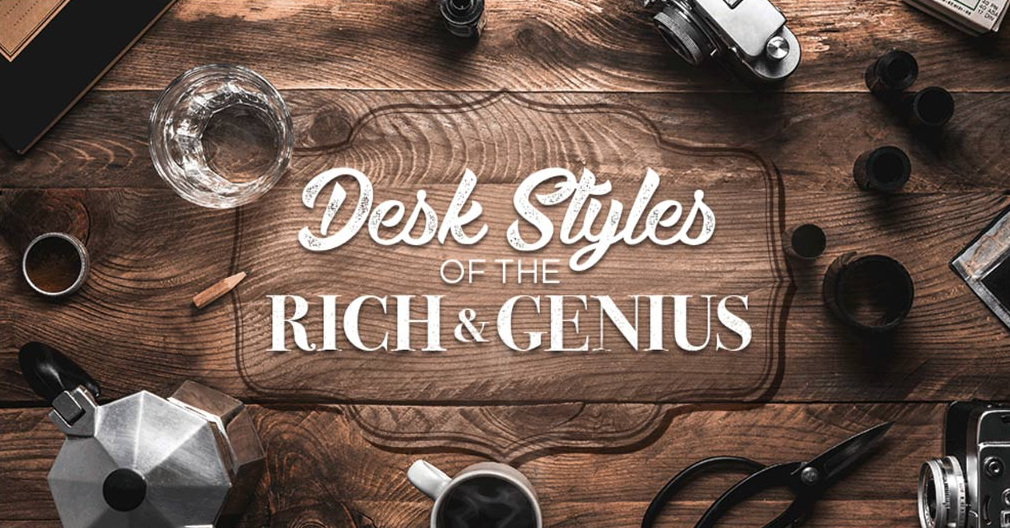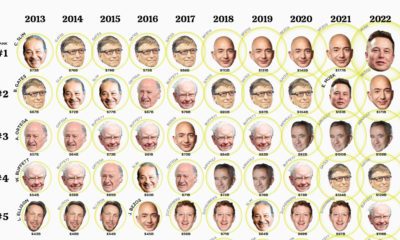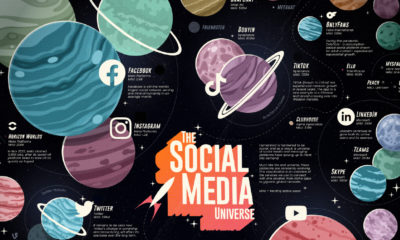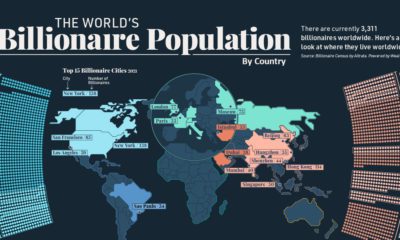Is it organized chaos, bursting with new plans and ideas to take the world by storm? Do sentimental photos of family and moments adorn the area surrounding the workspace? Is the desk organized, meticulously cleaned, and orderly? The structure of a person’s work environment, along with the routines they use for enhancing productivity while at the office, can help give us insight on how they work best – and this becomes especially interesting when we look at the strategies and tactics used by some of the world’s most extraordinary people.
Famous Desks and What We Can Learn
Today’s infographic comes from the Pens.com, and it highlights the work habits, routines, and desks from extraordinary people like Albert Einstein, Ernest Hemingway, Arianna Huffington, Elon Musk, and Mark Zuckerberg. Let’s see what we can take away from these examples:
Each approach above is unique – and each set of tactics helps that extraordinary person in getting closer to reaching their objective.
Lessons from the Greats
Here are some of our favorite lessons that we thought were the most tangible: Mark Zuckerberg Consistent with his grey t-shirt and jeans approach to his wardrobe, Zucks also keeps his workspace simple. He doesn’t have an office, and instead works with the same desk setup as every other Facebook employee. Lesson: As a leader, the way you dress and set up your work environment also communicates your values to the organization and the outside world. Mark Zuckerberg keeps his environment simple to help him focus on the bigger problems, and this vision shines through crystal clear to inspire the people around him. Elon Musk At the Tesla office, Elon Musk set his desk up at the end of the Model X assembly line so he could personally inspect each finished vehicle. Lesson: When doing something bold and visionary, there must be constant attention to detail to ensure that the end product meshes with the vision. Elon could have put his desk somewhere with a nice view, or in a corner office. Instead, by setting up his desk in this strategic position, it gave him assurance that the vehicles coming off the line were going to meet his uncompromising quality standards. Albert Einstein Einstein believed that cluttered desks were the sign of a cluttered brain, with lots of things going on. As such, he wondered what was going on in the brains of people with perfectly tidy workspaces! Einstein also thought that combining unrelated concepts to generate new, creative ideas was a secret of genius. Lesson: Studies have shown that messy desks are linked to creativity – something that Einstein needed when solving “outside the box” physics problems like relativity. Arianna Huffington For anyone that has read her book, Sleep Revolution, it’s clear Arianna Huffington believes that people are generally quite sleep-deprived. For these reasons, she encourages naps to boost productivity in the workplace. Lesson: Arianna Huffington has “owned” the discussion around sleep, and how proper habits can help with work productivity. It’s no surprise she walks the talk, as well. Ernest Hemingway Hemingway thought he did his best work standing up, and he also kept a tally of his daily word count in front of him. Lesson: While studies show working while standing up can enhance productivity by 10% – more importantly, Hemingway did what works best for him, even though it was unconventional. He also knew that monitoring his most important KPI, and keeping that metric right in front of him, would allow him to best gauge his progress on achieving his vision.
on Even while political regimes across these countries have changed over time, they’ve largely followed a few different types of governance. Today, every country can ultimately be classified into just nine broad forms of government systems. This map by Truman Du uses information from Wikipedia to map the government systems that rule the world today.
Countries By Type of Government
It’s important to note that this map charts government systems according to each country’s legal framework. Many countries have constitutions stating their de jure or legally recognized system of government, but their de facto or realized form of governance may be quite different. Here is a list of the stated government system of UN member states and observers as of January 2023: Let’s take a closer look at some of these systems.
Monarchies
Brought back into the spotlight after the death of Queen Elizabeth II of England in September 2022, this form of government has a single ruler. They carry titles from king and queen to sultan or emperor, and their government systems can be further divided into three modern types: constitutional, semi-constitutional, and absolute. A constitutional monarchy sees the monarch act as head of state within the parameters of a constitution, giving them little to no real power. For example, King Charles III is the head of 15 Commonwealth nations including Canada and Australia. However, each has their own head of government. On the other hand, a semi-constitutional monarchy lets the monarch or ruling royal family retain substantial political powers, as is the case in Jordan and Morocco. However, their monarchs still rule the country according to a democratic constitution and in concert with other institutions. Finally, an absolute monarchy is most like the monarchies of old, where the ruler has full power over governance, with modern examples including Saudi Arabia and Vatican City.
Republics
Unlike monarchies, the people hold the power in a republic government system, directly electing representatives to form government. Again, there are multiple types of modern republic governments: presidential, semi-presidential, and parliamentary. The presidential republic could be considered a direct progression from monarchies. This system has a strong and independent chief executive with extensive powers when it comes to domestic affairs and foreign policy. An example of this is the United States, where the President is both the head of state and the head of government. In a semi-presidential republic, the president is the head of state and has some executive powers that are independent of the legislature. However, the prime minister (or chancellor or equivalent title) is the head of government, responsible to the legislature along with the cabinet. Russia is a classic example of this type of government. The last type of republic system is parliamentary. In this system, the president is a figurehead, while the head of government holds real power and is validated by and accountable to the parliament. This type of system can be seen in Germany, Italy, and India and is akin to constitutional monarchies. It’s also important to point out that some parliamentary republic systems operate slightly differently. For example in South Africa, the president is both the head of state and government, but is elected directly by the legislature. This leaves them (and their ministries) potentially subject to parliamentary confidence.
One-Party State
Many of the systems above involve multiple political parties vying to rule and govern their respective countries. In a one-party state, also called a single-party state or single-party system, only one political party has the right to form government. All other political parties are either outlawed or only allowed limited participation in elections. In this system, a country’s head of state and head of government can be executive or ceremonial but political power is constitutionally linked to a single political movement. China is the most well-known example of this government system, with the General Secretary of the Communist Party of China ruling as the de facto leader since 1989.
Provisional
The final form of government is a provisional government formed as an interim or transitional government. In this system, an emergency governmental body is created to manage political transitions after the collapse of a government, or when a new state is formed. Often these evolve into fully constitutionalized systems, but sometimes they hold power for longer than expected. Some examples of countries that are considered provisional include Libya, Burkina Faso, and Chad.

















